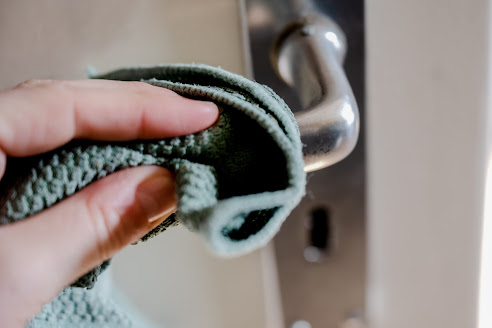 |
| Cleaning surfaces with alcohol-based disinfectant is a good protection against infection. Photo Credit: © RUB, Marquard |
The virus remains infectious on steel surfaces for up to 30 days, but can be effectively deactivated by alcoholic disinfectants.
Pockenviruses are known to remain infectious in the area for a very long time. A study by the Molecular and Medical Virology Department at the Ruhr University Bochum showed that the temperature is very important: at room temperature, it can take up to eleven days until there is no longer a reproductive monkeypox virus on a stainless-steel surface, at four degrees Celsius even up to a month. Accordingly, it is particularly important to disinfect surfaces. According to the study, alcoholic disinfectants work well against monkeypox viruses. However, hydrogen peroxide-based disinfectants are not sufficiently effective. The team reports in Journal of infectious diseases.
Weekly observation
Since 2022, the monkey pox virus has been spreading from person to person. Even if the infection is primarily due to direct physical contact, it is possible to infect yourself via contaminated surfaces, for example in the household or in hospital rooms. "Pockenviren is known to remain infectious in the area for a very long time," explains Dr. Toni Meister from the Department of Molecular and Medical Virology at Ruhr University. “So far we have not known the exact times for monkey pox."
The researchers therefore examined them by applying the virus to cleaned stainless steel plates and keeping them at different temperatures: at four degrees, at 22 degrees, which corresponds to approximately room temperature, and at 37 degrees. They determined the number of infectious viruses after waiting times of different lengths between 15 minutes and several days to weeks.
Viruses remain contagious for a long time
Regardless of the temperature, the number of infectious viruses changed little in the first few days. At 22 and 37 degrees, the virus concentration only decreased significantly after five days. At 37 degrees, no reproductive virus was found after six to seven days, at 22 degrees it took ten to eleven days until infection was no longer possible. At four degrees, the amount of virus only decreased sharply after 20 days, after 30 days there was no longer any risk of infection. "This coincides with the experience that even after almost two weeks you can still get infected with monkey pox surfaces in the household," says Prof. Dr. Eike Steinmann, head of the Molecular and Medine Virology department.
In order to reduce the risk of infection in the event of an outbreak, the disinfection of surfaces is particularly important. The researchers therefore tested the effects of five commercially available disinfectants. Result: Alcohol or aldehyde-based agents reliably reduced the risk of infection. However, a hydrogen peroxide-based disinfectant did not sufficiently inactivate the virus in the study. "Our results support WHO's recommendation to use alcohol-based surface disinfectants," said Toni Meister.
Funding: The study was funded by VIRus ALlianz (VIRAL) North Rhine-Westphalia, Ministry of Culture and Science NRW (funding code 323-8.03-151826), the Federal Ministry of Education and Research (Project VirBio, funding code 01KI2106).
Published in journal: Journal of infectious diseases
Additional information: Authors: Toni Lusie Meister, Yannick Brüggemann, Daniel Todt, Ronny Tao, Lisa Müller, Jochen Steinmann, Joerg Steinmann, Joerg Timm, Ingo Drexler, Eike Steinmann.
Source/Credit: Ruhr University Bochum
Reference Number: vi051623_01







.jpg)